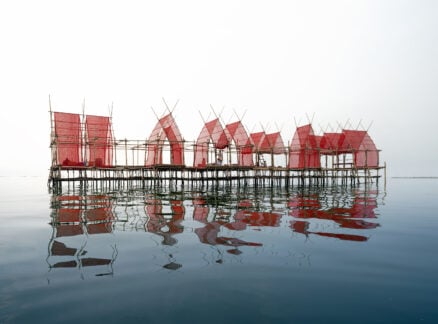July 1, 2009
Fearless Flying
A new competition encourages architects to design kites using any material under the sun.
On a recent Saturday afternoon in Manhattan’s Riverside Park, Sean Smith attached a swath of white cotton to a $3 Kmart line set and, holding the contraption aloft, cut circles around himself as the fabric puffed, then deflated, in vigorous bursts. The Brooklyn-based postproduction video editor was one of 60 entrants in FlyNY, the first annual international kite-design competition for architects, engineers, and artists, and he was doubtless the most resourceful—his kite was made of underpants. (Unused, he pointed out.)
Skeptics might legitimately wonder what Fruit of the Looms (size large) have to do with architecture. To hear Victoria Partridge Walsh, one of FlyNY’s directors, tell it, designing a kite is, as in any architecture contest, about problem solving and aesthetics; making something fly and getting it noticed. “An architect has as much to learn from this competition as a kid would,” she says. “It’s an exercise in craft, form, and physics.” FlyNY, which auctioned its winning kites in May to benefit Architecture for Humanity New York (AFHny), acts as an instructional tool, forcing architects to consider all aspects of construction while setting them free from the quotidian business of building buildings.
The German architect Heinrich Hohmann captured first prize for a rectangular kite inspired by ancient Japanese fliers. Fabricated with ripstop nylon and a carbon-fiber frame, the kite is an abstract interpretation of New York’s skyline. “In the air, the planes of color popped into a 3-D image that read like a perspective drawing,” says Cynthia Barton, AFHny’s director and a judge. “The effects were all the more beautiful for being unexpected.”
Not every entry was so scrupulous. A trio of tousled-haired volunteers from the Buckminster Fuller Institute sashayed onto the scene, an oversize kite (made of tetrahedral pyramids) in hand and a lofty explanation at the ready. “It’s Alexander Graham Bell’s idea,” one team member, Will Elkins, said. “Buckminster Fuller did this too. He patented the octet truss. It’s a frame that’s lightweight and strong—ideal for flying.” But when it came time to soar, the kite rose into the air, took a sharp right, and landed squarely on the head of a passerby.
“It’s not really about having it fly,” Elkins said, toying with the bridle, “as it is learning how it flies. That was Fuller’s ideology—experimenting to see what works.” It’s an apt articulation of the FlyNY ethos. Anything can be a design lesson—even a pair of tighty whities.





